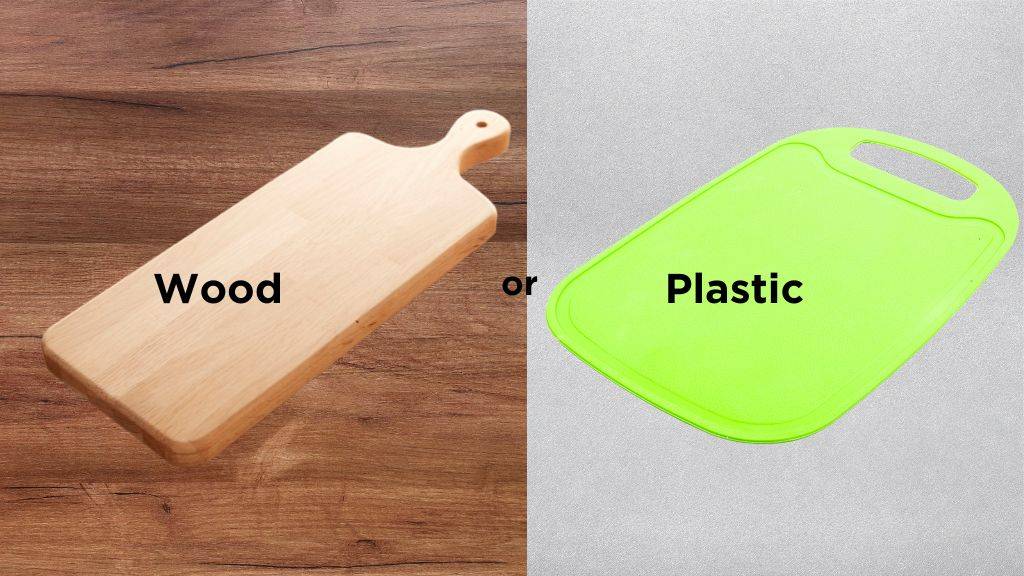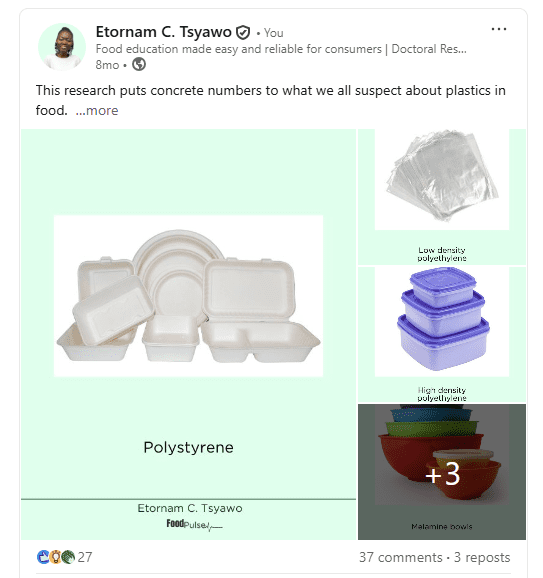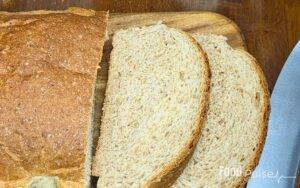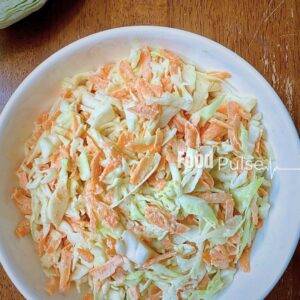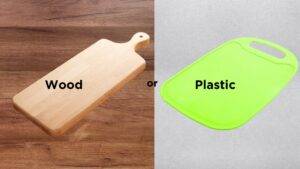If you’ve ever wondered whether plastic cutting boards are better or scared of wooden boards harbouring bacteria, and further confused as to which one to choose, you’re not alone.
You’ve likely heard plastic cutting boards are “safer” for good reason. They’re easier to clean, don’t absorb any liquids and more modern.
But then there’s also a warning to avoid plastic boards due to microplastics.
That’s a lot of doubts. Let’s clear them all up and answer the questions you have based on what science says and also based on reason.
A study published in the Journal of Food Protection showed that wooden cutting boards might actually be safer than plastic cutting boards when it comes to bacterial contamination.
Before you rush to replace all your kitchen gear to wood, let’s dig into what this research really means for your use of cutting boards.
The study on cutting boards
Researchers at the University of Wisconsin-Madison compared how plastic and wooden cutting boards handle bacterial contamination under conditions similar to home kitchens.
They tested some disease-causing bacteria including E. coli and Salmonella, the kinds of pathogens you’d usually find on raw meat and poultry.
According to the results, when the bacteria were applied to plastic cutting boards, they not only survived but actually multiplied, especially when left overnight.
On the wooden cutting boards, however, the bacteria-containing fluids were absorbed within a few minutes and the bacteria became nearly impossible to recover.
You see, here’s what makes this research particularly interesting:
- With the level of contamination of the wooden cutting board, they could not recover the disease-causing micro organisms
- Even with heavy contamination (100 times normal levels), the bacteria couldn’t survive much after 12 hours
- Plastic boards always showed high levels of the bacteria, in fact, they multiplied

In simple terms, if you’ve ever been told plastic cutting boards are more sanitary than wooden cutting boards, this research is saying, that’s not the case. It’s the other way round.
Why this matters
This study was done in 1994. You might wonder, “ah! How’s this relevant today?”
Well, the fundamental properties of wood and plastic haven’t changed. Neither have the basic principles of food safety in home kitchens.
What makes this research still valuable is that it challenges assumptions many of us have been operating under for years.
The recommendation has been plastic cutting boards based on the theory that they’re easier to sanitize. Yes, plastic cutting boards might be easier to sanitize. But as this study shows, easier to sanitize doesn’t necessarily mean safer in real-world use.
The science behind wood's antibacterial properties
The wood is absorbing bacteria as well as actively working against them. Here’s what happens:
- Rapid absorption: the wood’s porous structure quickly pulls bacteria-containing liquids below the surface
- Natural drying: the wood’s ability to dry out creates an environment where the bacteria can’t thrive
- Bacteria elimination: once absorbed, the bacteria become unrecoverable even after trying to extract them (according to the research)
This natural antibacterial action is not present in plastics.
Here are some nuances about this cutting board study
Before we declare wooden boards the absolute winner, here are some limitations worth mentioning in this study:
- No standard testing method: there’s no universal standard for testing the safety of cutting boards. This means another testing method could actually change the results.
- Controlled lab conditions: real kitchens are messier and less controlled than lab environments
- Time factor: the study is from 1994. The basic science is still very relevant. But a more recent study with sample cutting boards from real kitchens with usage over time would be very interesting to explore.
This doesn’t invalidate the research, but it does mean you should view it as one important piece of a larger puzzle rather than the final word.
Because some research actually favored plastic boards, particularly when looking at ease of cleaning, performance after multiple uses and washings and resistance to knife damage.
How about microplastics on plastic cutting boards?
Today, many studies have shown that tiny plastic particles have been found throughout the human body.
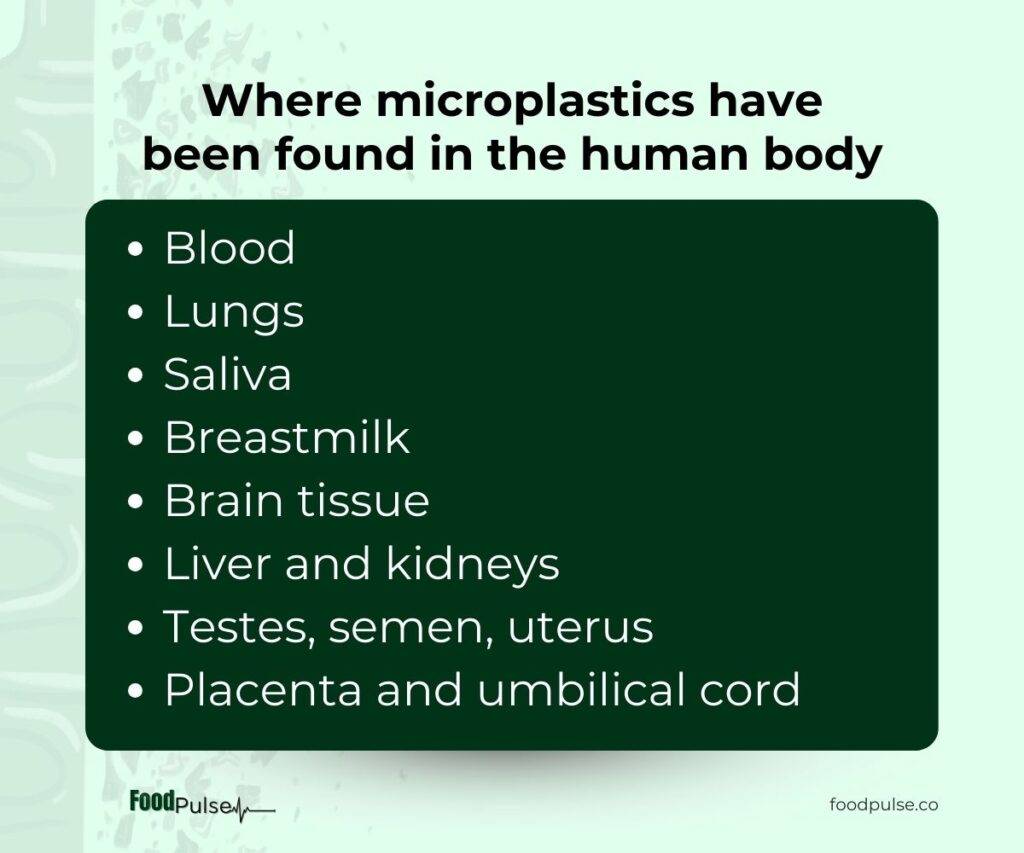
Every time someone cuts on a plastic board, especially one that’s been used and has knife grooves, they’re potentially creating more microplastic particles. Researchers may not yet fully understand the long-term health implications of microplastics but it’s important to take precaution and minimize your exposure where possible.
You can check this LinkedIn post for more on microplastics in food packaging.
So what does all these mean for your cutting board needs?
You don’t need to throw out all your plastic boards tomorrow, but you can make informed decisions moving forward.
1. When wooden cutting board makes sense
Wooden cutting boards work particularly well for:
- General food prep (meat, vegetables, fruits, herbs)
- Bread and baked goods
- Cheese and charcuterie
- Foods that won’t be cooked further
The key is proper maintenance: wash them promptly and properly. Don’t leave them soaking. Allow them to air dry completely. It’s also a good practice to have two separate wooden cutting boards – one for meat & meat products and another for other foods.
2. When plastic cutting board still makes sense
Plastic boards can be practical for:
- raw meat and poultry (if sanitization is your topmost priority)
- when deep cleaning is required
- temporary cooking situations
It’s a good practice to replace plastic boards once they start developing deep grooves from knife damage.
How to care for wooden cutting boards the right way
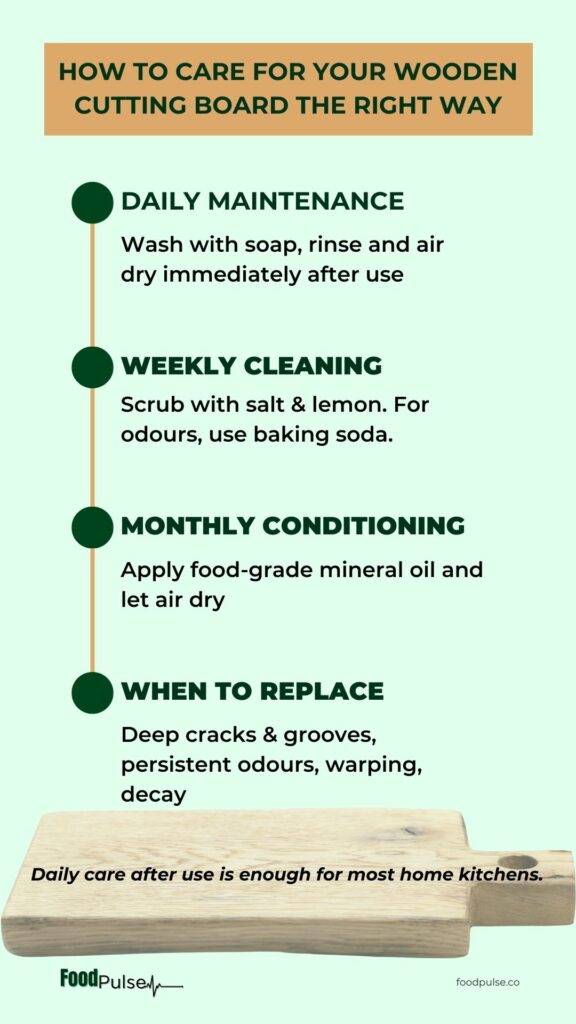
If you decide to embrace wooden cutting boards, proper care is essential. Here’s how to keep them safe and functional:
1. Daily maintenance
Wash with warm soapy water immediately after use
Never leave them soaking in water
Rinse thoroughly and air dry completely
Store in a well-ventilated area
2. Weekly cleaning
Scrub with coarse salt and half a lemon
Rinse and dry thoroughly
For stubborn odors, use a paste of baking soda and water
3. Monthly conditioning
Apply food-grade mineral oil (if you prefer)
Let the oil penetrate overnight, then wipe away excess and air dry
4. When to replace
Deep cracks grooves that harbor bacteria
Persistent odors that cleaning can’t eliminate
Warping or splitting that affects stability
Signs of damage or rottenness
For most normal home kitchens, daily maintenance right after use is enough to keep the wooden cutting board safe and ensure long term use.
More on (food-grade) mineral oil
The topic of mineral oil came up frequently in discussions. Mineral oil (colourless and odourless) is derived from petroleum. And it comes in various purity levels. The highest purity mineral oils are used in food and cosmetic applications.
Many wooden cutting boards are treated with mineral oil to prevent cracking and liquid absorption.
But this Wisconsin study found that treating the wood with mineral oil had minimal effect on the antimicrobial properties of wood.
Which means, whether the wooden cutting board is treated with mineral oil or not, the natural antibacterial properties we discussed earlier still work. This is actually good news if you prefer to avoid petroleum-derived stuff (even if they’re essentially harmless).
What this means for your cooking needs
The type of cutting board may matter less than how you use and maintain it. Whether you choose wood or plastic, these principles apply:
1. basic food safety
- Clean immediately after use, especially after raw meat contact
- Separate boards for raw meat and ready-to-eat foods
- Replace when damaged; deep grooves and cracks harbor bacteria
- Air dry thoroughly; bacteria thrive in moist environments
2. making a switch to wooden cutting boards
If you’re considering switching to wooden boards:
- start with one high-quality board for general use
- learn proper care techniques before expanding your collection
- keep your plastic boards for specific tasks if needed
- don’t feel pressured to replace everything at once
Remember that while cutting board material is important, it’s just one piece of kitchen food safety. Many more factors come to play to prevent foodborne illnesses including proper cooking, good hygiene, timely consumption, etc.
Your future cutting board purchases
As you shop for cutting boards, you may likely see some interesting developments that could make your choice easier:
Cutting boards with natural antimicrobial treatments that may not need special maintenance.
Expect hybrid materials that combine wood’s natural benefits with plastic’s convenience – giving you the best of both worlds without the trade-offs.
The research on cutting board safety may probably get more specific about real kitchen use (not just lab conditions), which should give us clearer guidance for everyday cooking.
It won’t be surprising if some manufacturers are already incorporating these into both wood and plastic options. With time, the options will only get better.
Should you choose a wooden cutting board or a plastic cutting board?
The choice between wooden and plastic cutting boards isn’t black and white. Both can be safe when used properly and both have their place in different kitchen scenarios.
If wooden boards’ natural antimicrobial properties appeal to you and you’re comfortable with the maintenance needs, they can be an excellent choice.
If you prefer the convenience and dishwasher-safety of plastic boards, that’s valid too. Just be sure to replace them when they show wear.
It boils down to personal preference as now, you know what each entails and even what (at least one) research says.
Want to simplify your food decisions? Get monthly insights that help you navigate food choices with confidence. No hype, just honest, research-backed guidance you can actually use.

Etornam is a Food Systems Research Engineer with a generous passion for healthy food. She’s the Founder of FoodPulse, a speaker and currently conducts doctoral research at McGill University on consumer food systems. She helps the everyday consumer navigate the modern food environment with confidence. She loves teaching, gardening and developing new recipes. Learn more by Etornam

